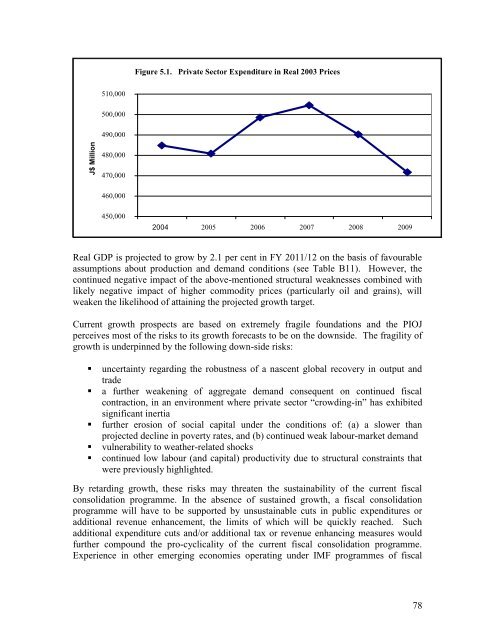PIOJ Growth-Inducement Strategy - Planning Institute of Jamaica
PIOJ Growth-Inducement Strategy - Planning Institute of Jamaica
PIOJ Growth-Inducement Strategy - Planning Institute of Jamaica
Create successful ePaper yourself
Turn your PDF publications into a flip-book with our unique Google optimized e-Paper software.
J$ Million<br />
Figure 5.1. Private Sector Expenditure in Real 2003 Prices<br />
510,000<br />
500,000<br />
490,000<br />
480,000<br />
470,000<br />
460,000<br />
450,000<br />
2004 2005 2006 2007 2008 2009<br />
Real GDP is projected to grow by 2.1 per cent in FY 2011/12 on the basis <strong>of</strong> favourable<br />
assumptions about production and demand conditions (see Table B11). However, the<br />
continued negative impact <strong>of</strong> the above-mentioned structural weaknesses combined with<br />
likely negative impact <strong>of</strong> higher commodity prices (particularly oil and grains), will<br />
weaken the likelihood <strong>of</strong> attaining the projected growth target.<br />
Current growth prospects are based on extremely fragile foundations and the <strong>PIOJ</strong><br />
perceives most <strong>of</strong> the risks to its growth forecasts to be on the downside. The fragility <strong>of</strong><br />
growth is underpinned by the following down-side risks:<br />
• uncertainty regarding the robustness <strong>of</strong> a nascent global recovery in output and<br />
trade<br />
• a further weakening <strong>of</strong> aggregate demand consequent on continued fiscal<br />
contraction, in an environment where private sector “crowding-in” has exhibited<br />
significant inertia<br />
• further erosion <strong>of</strong> social capital under the conditions <strong>of</strong>: (a) a slower than<br />
projected decline in poverty rates, and (b) continued weak labour-market demand<br />
• vulnerability to weather-related shocks<br />
• continued low labour (and capital) productivity due to structural constraints that<br />
were previously highlighted.<br />
By retarding growth, these risks may threaten the sustainability <strong>of</strong> the current fiscal<br />
consolidation programme. In the absence <strong>of</strong> sustained growth, a fiscal consolidation<br />
programme will have to be supported by unsustainable cuts in public expenditures or<br />
additional revenue enhancement, the limits <strong>of</strong> which will be quickly reached. Such<br />
additional expenditure cuts and/or additional tax or revenue enhancing measures would<br />
further compound the pro-cyclicality <strong>of</strong> the current fiscal consolidation programme.<br />
Experience in other emerging economies operating under IMF programmes <strong>of</strong> fiscal<br />
78
















